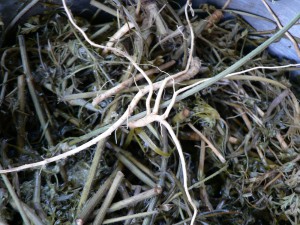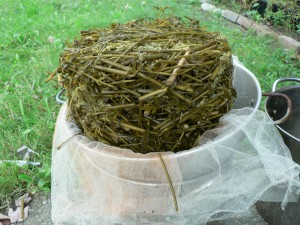Since Queen Anne’s Lace has been so abundant this year, I wanted to experiment with using the entire plant, roots and all, for dyeing. Quite a lot of plants needed to be weeded out of our garden plot, so on August 2nd I decided to try it. I was pretty certain it would make yellow, which is the most common color from wildflowers, but you never know until you try.
When I am dyeing, I often think of Jill Goodwin’s summary of her dyeing philosophy in her introduction to A Dyer’s Manual (12/24/2023 Edited to add that this link no longer works so I deleted it). I find two of her points especially comforting and motivational:
- “Only use the results of other people as a rough guide, for their conditions will not be the same as your own. Prove everything by your own efforts.”
- “Persevere with each problem, for sometimes after years of thought the solution will become clear.”
So, I do try to prove everything with my own efforts. And I try to persevere with each problem. Hopefully over the years I solve some of them.
I pulled up many plants and chopped them up with pruning shears. I got 4 lbs. 8 oz. of plant material. I liked the cauldron-esque look of the dye pots with stems, leaves, flowers, and especially the roots. Whereas the flowers alone smell lemony and sweet while they are simmering, the whole plant smells a bit more like carrots, as you might imagine. Lemony carrots.
The plant material did not soften much after simmering for an hour and soaking over night. I had crammed it so tightly into the pots that when I tipped them out, the material clung together. It reminded me of a cake. Queen Anne’s Lace cake.
On the left, below, is one of the skeins I dyed with just Queen Anne’s lace flowers, and on the right are the two skeins I dyed with the whole plant. It is a little bit hard to compare because I used two different yarns. Oftentimes different yarns take the same dye differently, so for a true comparison I ought to have used the same yarn for both dyebaths. But I didn’t. The yarn on the left is singles rug yarn, and the two on the right are a fine 2/8 wool. Both were mordanted with alum sulfate.
So, yes, the whole plant does yield yellow. No big surprises here. It’s a bit more on the brassy or old gold side of yellow, not as bright and clear as the flowers alone but still very nice indeed.
I could have exhausted the bath but it got moldy really fast. I think I could get a nice green with a copper after bath but that will have to wait for another day.



